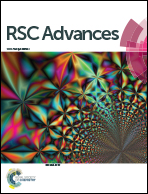Matrix effects caused by phospholipids in multi-residue analysis for beta-agonists with liquid chromatography-electrospray tandem mass spectrometry†
Abstract
It was first confirmed that 5 glycerophospholipids (GPs, (15.6 mg L−1)), including lysophosphatidylcholine (LPC C18:0), lysophosphatidylcholine, LPC (C16:0), phatidylcholine, PC (C16:0/C18:2), phatidylcholine, PC (C16:0/C18:1) and phatidylethanolamine, PE (C18:0/C20:4), could significantly suppress the ionization of nine beta-agonists (2 μg L−1) using post-column infusion during liquid chromatography-electrospray tandem mass spectrometry analyses. Under optimal experimental conditions, most beta-agonists such as fenoterol, clorprenaline, tulobuterol, clenbuterol and especially penbuterol were co-eluted with GPs, and a positive linear correlation (R2 > 0.85) between the amount of GPs and the extent of ionization suppression was observed for the five analytes. In addition, the linear correlation was statistically significant (p < 0.001). GPs including LPC C18:0 (m/z 496.2), PC C16:0/C18:2 (m/z 758.5), PC C16:0/C18:1 (m/z 760.5), PE C18:0/C20:4 (m/z 768.6) and plasmalogen phosphatidylcholine, PLPC C18 (Plasm)/C18:1 (m/z 772.6) were detected in the final extracts of porcine liver sample. These endogenous GPs may be the main effectors that cause matrix effects in beta-agonist residue detection in porcine liver.


 Please wait while we load your content...
Please wait while we load your content...